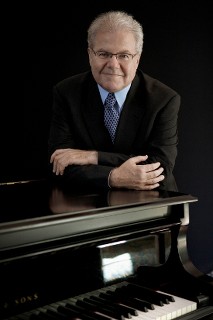|
Back
Songs Without (Or Sort Of With) Words New York
David Geffen Hall, Lincoln Center
10/01/2015 - October 3, 2015
Johannes Brahms: Tragic Overture, Opus 81 – Piano Concerto No. 2 in B flat major, Opus 83
Marc Neikrug: Canta-Concerto (World Premiere)
Sasha Cooke (Mezzo-Soprano), Emanuel Ax (Pianist)
New York Philharmonic Orchestra, Alan Gilbert (Music Director/Conductor)

E. Ax (© Marie Mazzucco/Sony)
If Emanuel Ax didn’t possess some of the most astonishing hands in the world, he could have been one of the most successful con-men. Coming on stage, as he did last night for his performance with the New York Philharmonic, he resembled less the great artist than Uncle Everyman. Shaggy, avuncular, a paradigm of the unprepossessing.
He sits on the stool gives an awkward “Hi” to Concertmaster Frank Huang, Mr. Gilbert allows the horn solo of the Brahms Second Piano Concerto to issue forth, his hands glide over the triplets, like he’s feeling the temperature, beckons the horn once more. And then Mr. Ax, the supposed Nice Guy, resemble Hurricane Sandy.
Not a crazy windstorm going in all directions at once. But a man who controls his universe, who, over three-quarters of an hour, allows passion, proficiency, warmth and heat to confront each other, make their peace and continue for which could turns Uncle Manny to Super-Manny.
For the second concert of the season, Alan Gilbert possibly felt that the appearance of Emanuel Ax would bring to rest whatever doubts one might have about the ultimate grading of the Orchestra. The opening-night Salonen and Strauss, allowed the Phil to show its muscle, its individual prowess. But this muscularity is the hallmark of all great American orchestras, from Los Angeles to Cleveland to Boston, even when non-Americans are conducting.
At the same time, the Brahms Second is that most unforgiving piece, a Bruckner-sized “symphony for piano” that can wear out performer and audience.
What Mr. Ax and longtime friend Maestro Gilbert accomplished was to bring the European sound to the orchestra. Well, not exactly. The orchestra in the first movement sounded a bit dull, a bit careful, a bit wary of Mr. Ax. After all, the “color” of orchestral Brahms at its best is a bit shaded. And no competition for Mr. Ax’s Steinway color.
The Brahms can sound exceedingly noble, but Mr. Ax gave it that human touch. A never-ending beauty and sonority of tone, and a never-failing humanity of conception in that complicated first movement. The scherzo was at times rugged, at times furious, the Phil’s timpani put to good use.
And whatever pleasure we felt for those first two movements, Mr. Gilbert’s cello section, with a gorgeous solo by Carter Brey and the most tender ensemble playing gave Mr. Ax the chance to perform this with poetry.
As expected, the whole Phil and the soloist vied for humor and vigor at the end. Most important, more than a jaunty finale, Brahms (and Ax) kept the organic movement to the very end. Those 45 minutes may be punishing at times, but at the end, the mundane idea of “duration” was not ever considered.
After the opening Brahms Tragic Overture, played with suitable careful tension, composer Marc Neikrug came on stage to introduce a New York Philharmonic commission dedicated “To Alan”, though it could equally have been dedicated to the mezzo-soprano for whom it was written, Sasha Cooke.
Canta-Concerto is obviously a concerto for singer, akin to Reinhold Glière’s Concerto and various vocalise’. Mr. Neikrug, though, is far too inventive to either a) make this a “la-la-la” piece for a singer to demonstrate her instrumental ability; or b) a work with words, like an extended four-movement concert aria.
Instead, Mr. Neikrug, a librettist himself, “invented” sounds to illustrate the music. Not nonsense syllables but tones and words which, though not apprehended, would complement the music.
I know not what Noam Chomsky would say about this. But Anthony Burgess once invented a language for the director of Quest For Fire. And he had a marvelous time using his own polymathic linguistic skills showing how early man might have given words to things in how they looked felt.
(If I remember, he had to give a name to a ball which “felt” both round and high!)
Mr. Neikrug didn’t go that far. His work, though, through the wonders of Ms. Cooke, gave all vastness of a concerto. As professional, and innovative and experienced as the composer, he didn’t give Ms. Cooke a cadenza (that would have been too obvious), nor did he ask her to perform those all too common vocal tricks with voice leaping, shrilling, groaning.
Rather, the artist performed an ominous operatic aria (it seemed) for the first movement (with the suitable “ah” and “oh” sounds which I made out), then a virtual duet with percussion for the second apparent scherzo (though not jokey). Another dramatic third movement, and an end which Mr. Neikrug said “owes more than a little bit to jazz”.
Well...not more than a little bit. Some Bernstein-like clatter at the beginning, much joyful sounds from Ms. Cooke, but it was pure Neikrug.
The composer is so deft, so sure of his workings, that sometimes the Canta-Concerto seemed more like a tour de force, a clever, likeable piece to test any soloist.
For if the Brahms showed a mighty 19th Century edifice to the gods, Mr. Neikrug composed a piece which we mortals heard, savored and relished.
Harry Rolnick
|